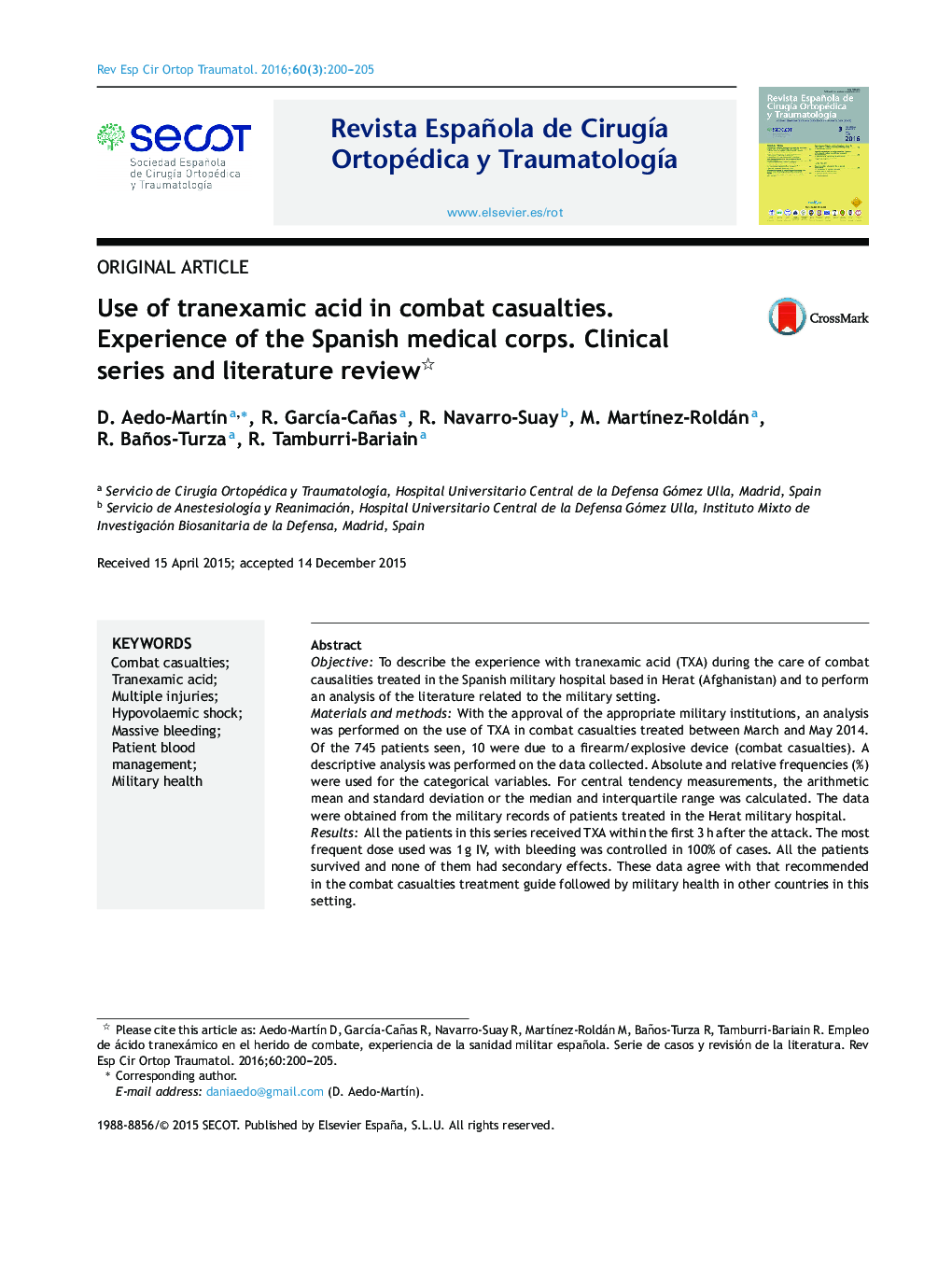| کد مقاله | کد نشریه | سال انتشار | مقاله انگلیسی | نسخه تمام متن |
|---|---|---|---|---|
| 4087050 | 1268010 | 2016 | 6 صفحه PDF | دانلود رایگان |
ObjectiveTo describe the experience with tranexamic acid (TXA) during the care of combat causalities treated in the Spanish military hospital based in Herat (Afghanistan) and to perform an analysis of the literature related to the military setting.Materials and methodsWith the approval of the appropriate military institutions, an analysis was performed on the use of TXA in combat casualties treated between March and May 2014. Of the 745 patients seen, 10 were due to a firearm/explosive device (combat casualties). A descriptive analysis was performed on the data collected. Absolute and relative frequencies (%) were used for the categorical variables. For central tendency measurements, the arithmetic mean and standard deviation or the median and interquartile range was calculated. The data were obtained from the military records of patients treated in the Herat military hospital.ResultsAll the patients in this series received TXA within the first 3 h after the attack. The most frequent dose used was 1 g IV, with bleeding was controlled in 100% of cases. All the patients survived and none of them had secondary effects. These data agree with that recommended in the combat casualties treatment guide followed by military health in other countries in this setting.ConclusionAll combat casualties were treated with TXA within the first 3 h. The most frequent dose used was 1 g IV and bleeding was controlled in all cases. All the patients survived with no adverse effects being observed.
ResumenObjetivoDescribir la experiencia obtenida con el ácido tranexámico (ATX) durante la atención a bajas de combate en el hospital militar español desplegado en Herat (Afganistán) y analizar la bibliografía relacionada en el ámbito militar.Material y métodosCon la aprobación de las instituciones militares pertinentes, se analizó la administración de ATX en bajas de combate entre marzo y mayo de 2014. De los 745 pacientes atendidos, 10 fueron por arma de fuego/artefacto explosivo (bajas de combate). El método estadístico empleado fue el descriptivo. Para variables categóricas se emplearon frecuencias absolutas y relativas en tanto por ciento (%). Como índices de la tendencia central, la media aritmética y la desviación estándar o la mediana y el rango intercuartílico. Los datos se obtuvieron del registro militar de pacientes atendidos en el hospital militar español de Herat.ResultadosEn nuestra serie de datos, todos los pacientes recibieron ATX antes de las 3 primeras horas tras el ataque. La dosis empleada más prevalente fue un gramo iv (intravenoso). La hemorragia fue controlada en el 100% de los casos. Todos los pacientes sobrevivieron y en ninguno se objetivaron efectos secundarios. Estos datos coinciden con lo recomendado en las guías de atención a la baja de combate seguidas por sanidades militares de otros países de nuestro entorno.ConclusiónTodas las bajas en combate fueron tratadas con ATX durante las 3 primeras horas. La dosis más prevalente fue de un gramo iv. La hemorragia fue controlada en la totalidad de los casos. Todos los pacientes sobrevivieron sin efectos secundarios.
Journal: Revista Española de Cirugía Ortopédica y Traumatología (English Edition) - Volume 60, Issue 3, May–June 2016, Pages 200–205
